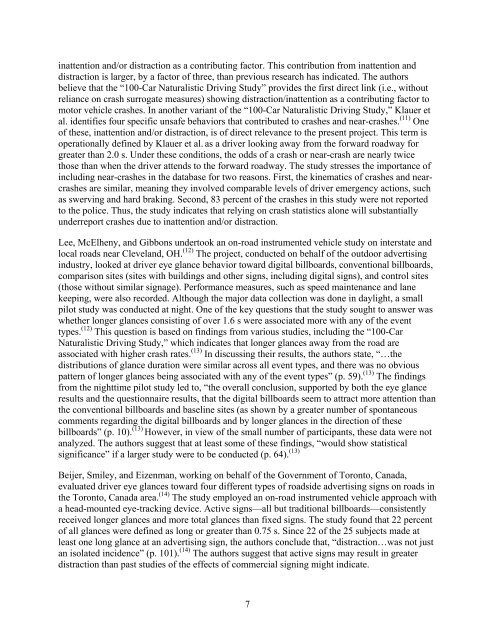The Effects of Commercial Electronic Variable Message Signs ...
The Effects of Commercial Electronic Variable Message Signs ...
The Effects of Commercial Electronic Variable Message Signs ...
You also want an ePaper? Increase the reach of your titles
YUMPU automatically turns print PDFs into web optimized ePapers that Google loves.
inattention and/or distraction as a contributing factor. This contribution from inattention and<br />
distraction is larger, by a factor <strong>of</strong> three, than previous research has indicated. <strong>The</strong> authors<br />
believe that the “100-Car Naturalistic Driving Study” provides the first direct link (i.e., without<br />
reliance on crash surrogate measures) showing distraction/inattention as a contributing factor to<br />
motor vehicle crashes. In another variant <strong>of</strong> the “100-Car Naturalistic Driving Study,” Klauer et<br />
al. identifies four specific unsafe behaviors that contributed to crashes and near-crashes. (11) One<br />
<strong>of</strong> these, inattention and/or distraction, is <strong>of</strong> direct relevance to the present project. This term is<br />
operationally defined by Klauer et al. as a driver looking away from the forward roadway for<br />
greater than 2.0 s. Under these conditions, the odds <strong>of</strong> a crash or near-crash are nearly twice<br />
those than when the driver attends to the forward roadway. <strong>The</strong> study stresses the importance <strong>of</strong><br />
including near-crashes in the database for two reasons. First, the kinematics <strong>of</strong> crashes and nearcrashes<br />
are similar, meaning they involved comparable levels <strong>of</strong> driver emergency actions, such<br />
as swerving and hard braking. Second, 83 percent <strong>of</strong> the crashes in this study were not reported<br />
to the police. Thus, the study indicates that relying on crash statistics alone will substantially<br />
underreport crashes due to inattention and/or distraction.<br />
Lee, McElheny, and Gibbons undertook an on-road instrumented vehicle study on interstate and<br />
local roads near Cleveland, OH. (12) <strong>The</strong> project, conducted on behalf <strong>of</strong> the outdoor advertising<br />
industry, looked at driver eye glance behavior toward digital billboards, conventional billboards,<br />
comparison sites (sites with buildings and other signs, including digital signs), and control sites<br />
(those without similar signage). Performance measures, such as speed maintenance and lane<br />
keeping, were also recorded. Although the major data collection was done in daylight, a small<br />
pilot study was conducted at night. One <strong>of</strong> the key questions that the study sought to answer was<br />
whether longer glances consisting <strong>of</strong> over 1.6 s were associated more with any <strong>of</strong> the event<br />
types. (12) This question is based on findings from various studies, including the “100-Car<br />
Naturalistic Driving Study,” which indicates that longer glances away from the road are<br />
associated with higher crash rates. (13) In discussing their results, the authors state, “…the<br />
distributions <strong>of</strong> glance duration were similar across all event types, and there was no obvious<br />
pattern <strong>of</strong> longer glances being associated with any <strong>of</strong> the event types” (p. 59). (13) <strong>The</strong> findings<br />
from the nighttime pilot study led to, “the overall conclusion, supported by both the eye glance<br />
results and the questionnaire results, that the digital billboards seem to attract more attention than<br />
the conventional billboards and baseline sites (as shown by a greater number <strong>of</strong> spontaneous<br />
comments regarding the digital billboards and by longer glances in the direction <strong>of</strong> these<br />
billboards” (p. 10). (13) However, in view <strong>of</strong> the small number <strong>of</strong> participants, these data were not<br />
analyzed. <strong>The</strong> authors suggest that at least some <strong>of</strong> these findings, “would show statistical<br />
significance” if a larger study were to be conducted (p. 64). (13)<br />
Beijer, Smiley, and Eizenman, working on behalf <strong>of</strong> the Government <strong>of</strong> Toronto, Canada,<br />
evaluated driver eye glances toward four different types <strong>of</strong> roadside advertising signs on roads in<br />
the Toronto, Canada area. (14) <strong>The</strong> study employed an on-road instrumented vehicle approach with<br />
a head-mounted eye-tracking device. Active signs—all but traditional billboards—consistently<br />
received longer glances and more total glances than fixed signs. <strong>The</strong> study found that 22 percent<br />
<strong>of</strong> all glances were defined as long or greater than 0.75 s. Since 22 <strong>of</strong> the 25 subjects made at<br />
least one long glance at an advertising sign, the authors conclude that, “distraction…was not just<br />
an isolated incidence” (p. 101). (14) <strong>The</strong> authors suggest that active signs may result in greater<br />
distraction than past studies <strong>of</strong> the effects <strong>of</strong> commercial signing might indicate.<br />
7

















